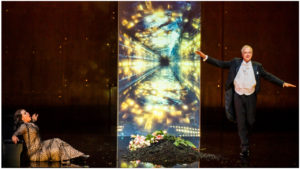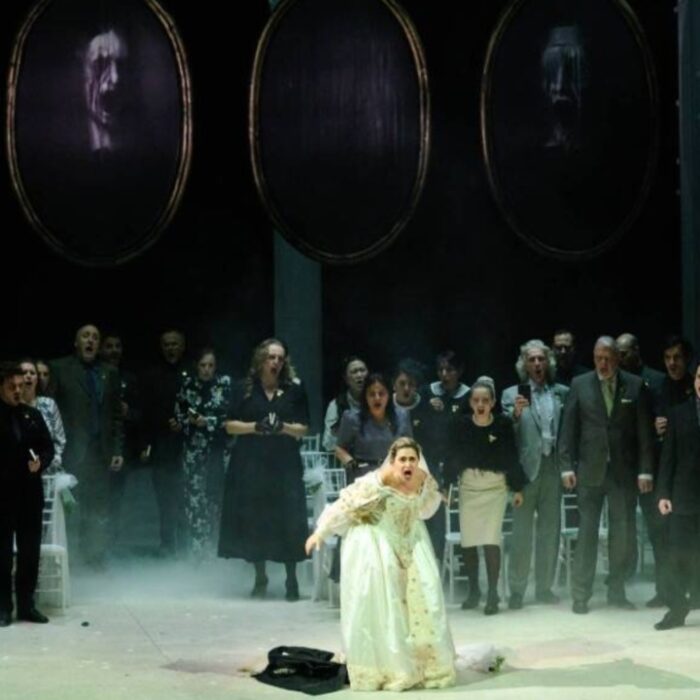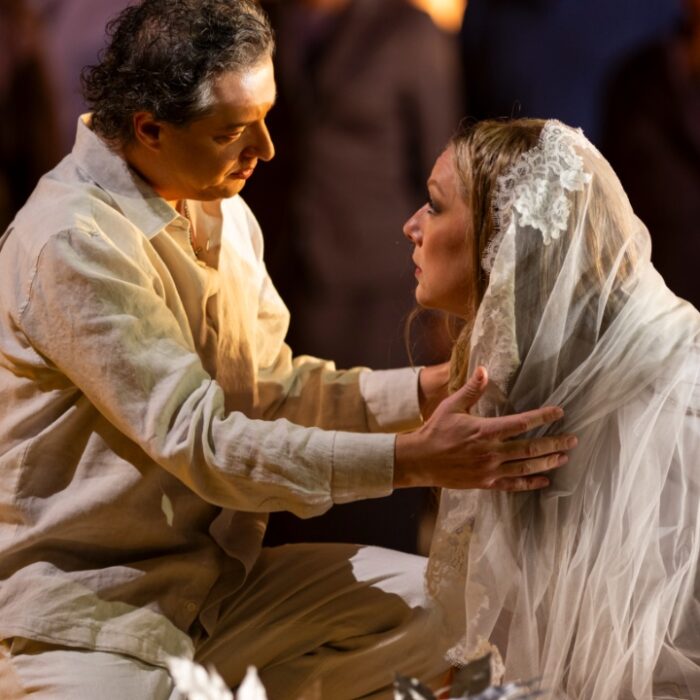
New York Philharmonic 2019-20 Review: Bluebeard’s Castle & Erwartung
Nina Stemme, Johannes Martin Kranzle, Katarina Karneus Shine In Unique Concert Experience
By Logan Martell(Credit: Chris Lee)
September 27, 2019, saw the second performance of the New York Philharmonic’s cerebral double bill, comprised of Bartok’s “Bluebeard’s Castle,” and Schoenberg’s “Erwartung.” Both works delve deeply into the psyche to explore themes of love, loss, trust, betrayal, and more.
Joined by some truly magnetic soloists, Jaap van Zweden and the Philharmonic succeeded in bringing the music, and mania, to the forefront of the evening.
Opening Expectations
First up was Schoenberg’s “Erwartung, from Vier Lieder, Op. 2, No. 1” which prefaced the half-hour work “Erwartung Op. 17,” exploring a brief episode of absolutely feverish emotional intensity as a woman tries to find her lover, only to discover his freshly-murdered corpse.
Director Bengt Gomer sets the stage with a bleak hospital setting as a group of coroners and gentlemen peer over a sheet-covered body. Soprano Nina Stemme slowly took to the lower level of the stage after being introduced by the languid beating harp, her fuller voice bearing a distanced anguish. A flash from the coroner’s camera marked the end of this prelude as the group slowly took their positions at the back of the stage for “Erwartung Op.17.” Emerging from the higher level was soprano Katarina Karneus, who marvelously sustained her vocal and dramatic talents through the psychological gauntlet of the story.
Karneus’ entrance was marked by the strange, atonal shades as the rest of the orchestra joined in the musical texture with restless calls and unsettled runs to highlight her angered, but searching, soprano, biting phrases such as “I go alone into the gloomy shadows” before twirling and humming bitterly. Schoenberg’s unconventional score provided fertile soil for the strange aural beauty as shrill violin holds tapered softly, or a descending celeste line gave way to a walking tuba, bolstered by weeping horns and constantly-wandering winds. Unafraid to join this unease, one bout of these orchestral flares saw Karneus employ a rolling shriek with the phrase “What if he’s ill?”
The discovery of the actual body diverges both musically and visually. Musically, as Karneus’ character finally comes upon her lover’s body, the massive orchestral crash and glaring light announced this tragedy like a clap of thunder in the emotional storm. Despite its impact, the discovery feels more like a confirmation of his death; Karneus’ grievous outpouring made it all too clear that her character’s mental suffering began much earlier. We saw her cross over to the body, lifting the sheet as she sings dreary, loving phrases such as “All light came from your eyes!” and even leaning into to give one final kiss.
For the sheer amount of meaning and importance musically and dramatically heaped upon the covered body, a final twist came when it was revealed to be a deer. This striking image would seem to suggest the sudden, tragic death of something fleeting, graceful, and beautiful; changing it from a human to an animal in a way allegorizes he woman’s loss, making it more about a lost concept than a lost lover. The only other motive or meaning that I can glean from this visual subversion would be to raise more questions rather than provide answers. Gomer’s set is one that plays with perceptions, as the stretching hallway projection blurs into the many branches of a forest.
An Utterly Dynamic Duo
Following intermission, the program continued with Bartok’s “Bluebeard’s Castle.” Among the changes to the minimalist set was the presence of seven robed women, at times still or in motion, who strongly gave the impression of muses. Giving the opening narration was Karneus, her firm tones paused when she lifted a megaphone to her face with every repetition of “ladies and gentlemen.” According to Bartok’s son, Peter: “The prologue is an essential part of the opera, as it contains the key to understanding the symbolic message. Its original text explains that the legend is but a frame for presenting our lives and their relation to others.”
The hour-long opera was enriched by the constant physical and vocal exchanges between Bluebeard and Judith, played by Johannes Martin Kranzle and Nina Stemme, respectively. Gomer’s direction changes the dynamic between the two, making it unclear just who is the one in control.
As Duke Bluebeard, Johannes Martin Kranzle delivered a remarkably nuanced performance; his physicality, voice, and expression revealed itself layer by layer until the audience sees his character in full. We see Kranzle enter with a fully-buttoned coat and a guarded bearing as he made certain of Judith’s devotion. Gomer’s direction tied the duke’s actions and responses to musical structures representative of the castle. As Judith readied to open the first door, the pressured Bluebeard opened his coat for relief, breathing in deeply as the castle moaned. When she pressed herself into him, his arms were held out to the side as if he did not know how to interact with her flirtations.
While the first and second doors imbued his character with sufficient danger, featuring blaring orchestral tones and a madly running xylophone melody, he is soon at Judith’s playful mercy as she uses one of the swords from his armory to force him to hand over the next key. The fifth door was announced with the expansive, utterly proud, organ theme which van Zweden and orchestra drew out gloriously; this musical revelation saw Kranzle standing tall, while Stemme was literally floored.
As Bluebeard’s latest bride, Judith, Nina Stemme employed a number of captivating tactics to ensure she bent Bluebeard to her will until the very end. Still bearing the flowers she carried for the opening songs of “Erwartung,” Stemme dashed these to the ground when she affirms her love with the phrase “I have left father and mother for you,” with Bluebeard reassembling them for the fourth door’s garden. From the first of the warning signs, her Judith keeps her concerns close to her breast, with hesitant, almost-fearful legato as she remarked upon the weeping castle walls. This vocal quality returns when faced with the first door’s torture chamber, leading to an instance of sonorous self-deception as she claimed to be brightening the room.
Stemme’s abundant vocal and dramatic passion wonderfully built up the ensuing tragic end; the sincerity of her love for Bluebeard did not fail to reach the duke as he agonized over giving her the remaining keys, knowing well what it would mean for her. As the basses rose powerfully, the two knelt and kissed passionately, with Bluebeard reduced to a panting mess on the floor as he gave her the final key. All this passion was frozen in its tracks as Judith is awed by the lineup of Bluebeard’s past wives, backed by the dirge-like horns and winds, resulting in a proud, but conflicted texture as the duke detailed what they brought to his life. Her trance-like responses to their beauty and splendor smoothly transitioned to fear as her realization sunk in poignantly; while there was not much in the way of costumes to visually cement Judith’s sealing away, Stemme’s expressions did much to mark this change as she is flanked by the onstage muses.
With his latest bride in her final resting place, Kranzle’s Bluebeard sat reflectively before a projected starry sky; as his thoughts trailed off into silence, the woodwinds repeated the initial theme as the graceful dissonant tones of the orchestra come softer with each repetition until they too are brought to a gentle close.
Friday evening’s double bill succeeded on many fronts, thanks to the great pairing of the works, evocative conducting, and inspired direction.
While Gomer’s production achieved much with a highly limited set, some of the more shocking moments within the works, such as the final reveal in “Erwartung,” suffer from its strangeness. Nonetheless, the New York Philharmonic staged a sensational and highly thought-provoking concert.



